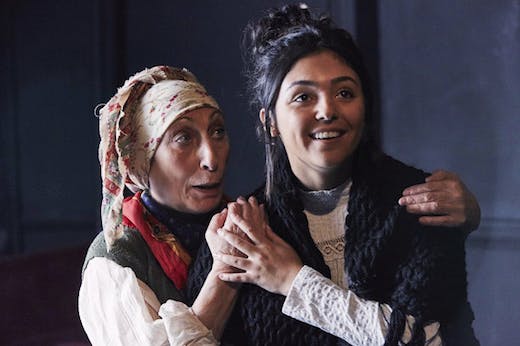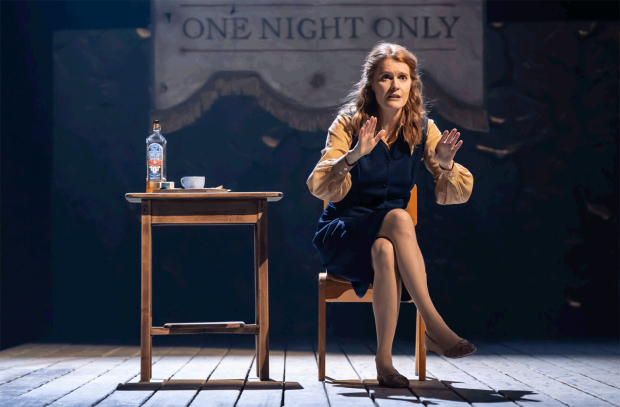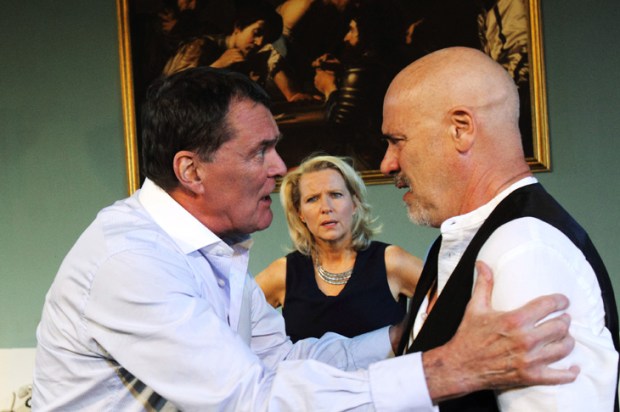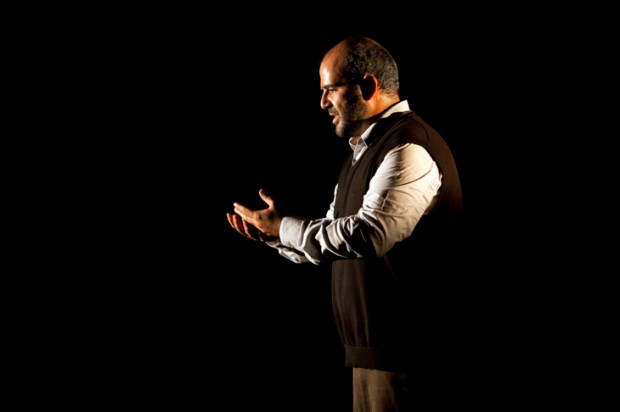Here are three truths about play-writing. A script without an interval will be structurally flawed. A vague, whimsical title means a vague, whimsical drama. And a play about Alzheimer’s will self-destruct for the obvious reason that drama is an examination of character while Alzheimer’s is an effacement of character, so the paint evaporates before it reaches the canvas. A fourth truth is that subsidised theatres know nothing of the first three. So that explains Plaques and Tangles at the Royal Court, which runs for 110 uninterrupted minutes, without the variations of mood generated by an interval, and which examines a case of early-onset dementia.
Megan is a married librarian with two kids. We watch her develop from the age of 22 to about 45 when her mind starts to go wibbly-wobbly. Playwright Nicola Wilson works hard to make Megan eccentric and attractive. She’s smart, sensuous, irascible, impulsive, well-educated and fascinated by words. But she doesn’t wear her erudition lightly. It wears her heavily. She discusses abstruse etymologies and the origins of proverbs. She quotes Gabriel García Márquez and early imprints of the New Oxford American Dictionary. To emphasise her lingual facility she regularly leaks into German without warrant, or translation. There’s no room for fun in this portrait because, I imagine, the writer’s aim is to put a ‘powerful intelligent matriarch’ on stage.
Wilson seems to realise that once Megan departs, the play goes with her so she postpones the valediction by flipping back into Megan’s early history and by accessorising the script with expressionist platitudes. There are ghost scenes and dream sequences. There’s a lecture-y bit, for schools perhaps, explaining the biochemistry of dementia. And we enjoy a Luis Buñuel moment where the actors become automatons and move jerkily backwards pretending to be stuck in a rewinding film. Megan’s penultimate gesture is to wear a purple bra over her dress and to microwave ‘waffles’ (in fact, the family laptops). At the same time she asks her husband to join her on one last adventure. ‘Learn Mandarin,’ she suggests. We don’t see the results of that linguistic expedition.
Wilson pads out the closing scenes with extra tragedies that can’t touch Megan because she’s beyond reach by this time. Her mental collapse is signalled by the famous ‘grin’ — a dreamy moist-eyed, slack-jawed smirk — often seen in zombie movies and in Ophelia’s final ‘good night, sweet ladies’ scene. The ‘grin’ is sometimes accompanied by dribble. This play is a decent stab at an impossible subject and the writer has at least learned that turning Alzheimer’s into theatre is like building a surfboard out of sawdust. A final thought. The director casts two actresses of different race to play older and younger Megan. In her twenties Megan is black and she turns white with dementia. There may be a touch of glamorous self-laceration here. Alzheimer’s doesn’t just curdle your noodle it turns you into an imperialist honkie bloodsucker too.
David Pinski’s Treasure
Treasure is the UK première of a Yiddish drama by David Pinski. The script, dating from 1905, has been adapted by Colin Chambers who styles himself ‘a former Literary Manager of the Royal Shakespeare Company’ and ‘Emeritus Professor of Drama at Kingston University’. His taste for otiose superfluity spills over into his clotted, slow-motion script. It’s a simple rustic tale. We’re in Russia. A beautiful peasant girl unearths a stash of gold in a graveyard and outrages her parents by keeping its location secret while kitting herself out in silk dresses to bag an eligible stud. A film would explain that set-up in half a dozen images. Here it takes half an hour. The action finally gets started when an oily matchmaker arrives followed by his fellow villagers all claiming a slice of the loot. The story develops into a tale of good luck turning nasty. There are some exquisite touches. The floorboards of the peasant’s kitchen are prised loose and raised upwards into the vertical slabs of a Jewish cemetery. Three little boys recite charming speeches among the gravestones. In the final tableau young men in white shirts and prayer shawls recite solemn chants by candlelight.
But the show is a disappointment because, oddly enough, it’s not sufficiently Jewish. The elements of Semitic drama, especially New York Semitic drama, are familiar to all of us, and I was expecting the full menu of kosher treats in protean form. All were missing. There was no wise-cracking hypochondriac, no angry patriarch with a heart of gold, no closet atheist secretly engaged to a blonde shiksa, no chicken soup. Pinski’s stagecraft lacks subtext or guile. And the acting doesn’t help. The overloud thesps bash out their lines at high volume like a novelty act of Scottie dogs barking ‘Auld Lang Syne’. The Finborough’s commitment to literary archaeology is a vital asset to the theatre. Alas, not every dig yields a classic.
Got something to add? Join the discussion and comment below.
Get 10 issues for just $10
Subscribe to The Spectator Australia today for the next 10 magazine issues, plus full online access, for just $10.















Comments
Don't miss out
Join the conversation with other Spectator Australia readers. Subscribe to leave a comment.
SUBSCRIBEAlready a subscriber? Log in